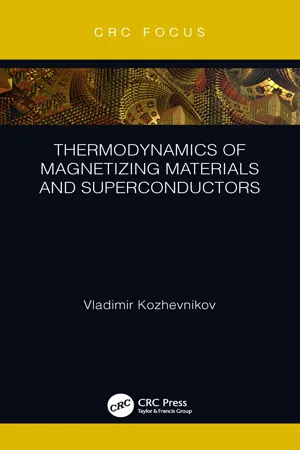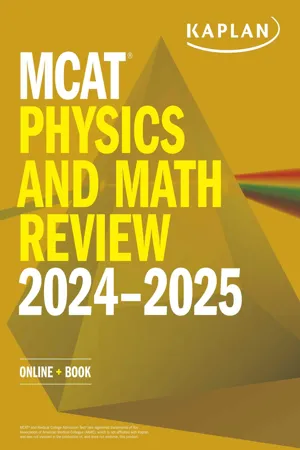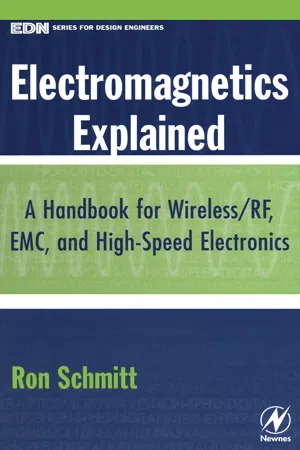Physics
Magnetostatics
Magnetostatics is the study of magnetic fields in systems that are not changing with time. It deals with the behavior of magnetic fields in materials and their interactions with electric currents. Key concepts include the magnetic field produced by a current-carrying wire, the magnetic force on a moving charged particle, and the behavior of magnetic materials in external magnetic fields.
Written by Perlego with AI-assistance
Related key terms
Related key terms
1 of 4
Related key terms
1 of 3
5 Key excerpts on "Magnetostatics"
- eBook - ePub
- A. L. Stanford, J. M. Tanner(Authors)
- 2014(Publication Date)
- Academic Press(Publisher)
16Magnetic Fields I
Publisher Summary
This chapter discusses magnetism, which refers to a group of phenomena that result from forces acting on charges because of the motion of those charges. These magnetic forces exerted on moving charges are usually described in terms of magnetic fields in a way that is similar to that of describing forces exerted on static charges in terms of electric fields. Thus, electric fields have their origins in static charges, and magnetic fields originate within moving charges. Increasing the charge or speed of the particle or increasing the magnitude of the magnetic field causes a proportionate increase in the magnitude of the magnetic force on the particle. The simple name, magnetic field, is sometimes called by more impressive names such as magnetic induction, magnetic flux density, and magnetic field induction. This frequency, which is independent of the speed of the particle, is sometimes called the cyclotron frequency.Magnetism refers to a group of phenomena that results from forces that act on charges because of the motion of those charges. These magnetic forces exerted on moving charges are usually described in terms of magnetic fields in a way that is similar to that of describing forces exerted on static charges in terms of electric fields. Thus, electric fields have their origins in static charges, and magnetic fields originate within moving charges.We will describe magnetic forces in terms of fields by considering:1. How the presence of a magnetic field causes force to be exerted on moving charges. 2. How magnetic fields are themselves produced by moving charges.16.1 Magnetic Forces on Moving Charges
Just as the electric field E is defined at a point in terms of the force F e = q E on a static charge q at that point, we may define the magnetic field B at a point in terms of a force relationship between the magnetic field and a moving charge. The magnetic field B - eBook - ePub
- Anupam Garg(Author)
- 2012(Publication Date)
- Princeton University Press(Publisher)
16 Magnetostatics in matterOur purpose in this chapter is to obtain a theory for the spatially averaged or macroscopic magnetic field in matter and to develop models for the response of certain types of materials to applied magnetic fields. While the mathematical development parallels that of electrostatics in dielectrics, the physics is quite different. The biggest difference is that, unlike the electric case, the magnetic susceptibility may be either positive or negative, i.e., the magnetic response can either oppose or reinforce the applied field. The two cases are known as diamagnetic and paramagnetic , respectively. This difference can be traced to the lack of any work done by the magnetic field on a moving charge. Second, except for ferromagnets and superconductors, the response is much weaker than in the electric case. Thus, there is often little penalty for confusing the magnetic field B with the magnetizing field H , and many authors even use the symbols interchangeably. This leads to much confusion, which we shall avoid with only partial success.100 Magnetic permeability and susceptibility
In Magnetostatics, where we study only steady-state situations, the macroscopic equations to be solved are Ampere’s law,and the law that B is solenoidal,As in the electrostatic case, one needs a constitutive relation between B and H to solve eqs. (100.1) and (100.2). For many materials a linear relationship holds to very good approximation over a large range. If the material is isotropic, we write1The dimensionless number μ (in the Gaussian system), or μ/μ 0 (in SI), is known as the permeability of the medium. It has the same value in the two systems. In solid or liquid crystals, it must be replaced by a tensor.We also define the magnetic susceptibility in parallel with the electric susceptibility:This is related to the permeability via It is also a dimensionless number, butFor the majority of materials for which eq. (100.3) is a good approximation,χmis very small, of order 10−5 . As mentioned above, unlikeχe,χmcan be either positive (paramagnets ) or negative (diamagnets ). Because of the smallness ofχm, if either a para- or diamagnetic body is placed in an external B - Vladimir Kozhevnikov(Author)
- 2019(Publication Date)
- CRC Press(Publisher)
Chapter 1 Elements of Magnetostatics in Magnetizing Media The magnetic moment and other magnetic properties of materials are caused by microscopic electric currents circulating inside them (recall that intrinsic magnetic moment of electron associated with its spin angular momentum is also attributed to circulating currents [ 3, 4 ]). The magnetic moment (or dipole magnetic moment) of a body is defined as [ 5, 6 ] M = 1 2 c ∫ V (r × j) d V (1.1) M = 1 2 ∫ V (r × j) d V, (SI) where r is the radius-vector from an origin somewhere inside the body to a physically infinitesimal element 1 of its volume dV in which the mean density of microscopic currents is j and the integral is taken over the whole volume of the body V ; and c is the. electrodynamic constant of the cgs unit system equal to speed of light. The mean current density j = e n v ¯ m i c, where e, n and v mic are charge, number density and velocity of microscopic motion of electrons, respectively. 1.1 Dielectrics In insulators or dielectrics, electrons are bound to molecules. Accordingly, microscopic currents are referred to as bound currents. Denoting the mean density of these currents j b, Eq. (1.1) is rewritten as M = 1 2 c ∫ V (r × j b) d V = ∫ V I d V, (1.2) where we introduced magnetization I, which is magnetic moment density or the moment per unit volume. As seen from (1.2), I is determined by the bound current j b and therefore it should be possible to express j b in terms of I. Indeed, as one can show (see, e.g., [ 3, 7, 8 ]), the relationship between j b an I is j b = c ∇ × I (1.3) j b = ∇ × I. (SI) On first glance, Eq. (1.3) may look rather strange because it yields zero bound current in uniformly magnetized bodies. But if it is so, then, according to (1.2), the magnetic moment of such bodies and hence magnetization are zero as well! Oddly enough, j b in these bodies is indeed zero but M and I are not. Let us see how it happens. The bound current in Eq- No longer available |Learn more
MCAT Physics and Math Review 2024-2025
Online + Book
- (Author)
- 2023(Publication Date)
- Kaplan Test Prep(Publisher)
CHAPTER 5ELECTROSTATICS AND MAGNETISM
In This Chapter
Insulators and Conductors5.1 ChargesElectric Field5.2 Coulomb’s Law5.3 Electric Potential Energy5.4 Electric PotentialEquipotential Lines Electric Dipoles5.5 Special Cases in ElectrostaticsMagnetic Fields Magnetic Forces5.6 MagnetismConcept SummaryCHAPTER PROFILE
The content in this chapter should be relevant to about 7% of all questions about physics on the MCAT. This chapter covers material from the following AAMC content category:4C: Electrochemistry and electrical circuits and their elementsIntroduction
Electrostatics is the study of stationary charges and the forces that are created by and which act upon these charges. Without electrical charge, we would not be able to do many of the activities that we enjoy or consider essential to basic living. But living with electrical charge can also be dangerous and even deadly: magnify the small shock you receive from a doorknob after walking across a carpet, and you have the equivalent of a lightning bolt strong enough to stop a heart. This same concept can be used in life-saving therapy as well: cardioversion and defibrillation create a strong electrical current through the heart’s conduction system that attempts to resynchronize a pulse.In this chapter, we will review the basic concepts essential to understanding charges and electrostatic forces including conductors and insulators. We will review Coulomb’s law, which describes the attractions and repulsions between charged objects. Next, we will describe the electric fields that all charges create, which allow them to exert forces on other charges. After we’ve discussed how charges set up these fields, we’ll observe the behavior of charges that are placed into these fields. In particular, we will note the motional behavior of these test charges inside a field in relation to the electrical potential difference, or voltage, between two points in space. We can then determine the change in electric potential energy as the charge moves from a position of some electric potential to another. Next, we will describe the electric dipole and solve a problem involving one of the molecular dipoles most important to life on this planet: the water molecule. Finally, we will explore the topic of magnetic fields and forces. - eBook - ePub
Electromagnetics Explained
A Handbook for Wireless/ RF, EMC, and High-Speed Electronics
- Ron Schmitt(Author)
- 2002(Publication Date)
- Newnes(Publisher)
Chapter 6 , you will learn more about the vector potential when we discuss quantum physics.MAGNETIC MATERIALS
Diamagnetism
In Chapter 2 , you learned that different materials behave differently in electric fields. You learned about conductors and dielectrics. Electric fields induce reactions in materials. In conductors, charges separate and nullify the field within the conductor. In dielectrics, atoms or molecules rotate or polarize to reduce the field. Magnetic fields also induce reactions in materials. However, since there are no magnet charges, there is no such thing as a “magnetic conductor.” All materials react to magnetic fields similarly to the way dielectrics react to electric fields. To be precise, magnetic materials usually interact with an external magnetic field via dipole rotations at the atomic level. For a simple explanation, you can think of an atom as a dense positive nucleus with light electrons orbiting the nucleus, an arrangement reminiscent of the planets orbiting the sun in the solar system. Another similar situation is that of a person swinging a ball at the end of a string. In each situation, the object is held in orbit by a force that points toward the orbit center. This type of force is called a centripetal force. The force is conveyed by electricity, gravity, or the string tension, respectively, for the three situations. Referring to Figure 3.17 and using the cross product right hand rule, you find that the force due to the external magnetic field points inward, adding to the centripetal force. The increase in speed increases the electron’s magnetic field, which is opposite to the external field. The net effect is that the orbiting electron tends to cancel part of the external field. Just as the free electron rotates in opposition to a magnetic field, the orbiting electron changes to oppose the magnetic field. This effect is called diamagnetism
Index pages curate the most relevant extracts from our library of academic textbooks. They’ve been created using an in-house natural language model (NLM), each adding context and meaning to key research topics.
Explore more topic indexes
Explore more topic indexes
1 of 6
Explore more topic indexes
1 of 4




